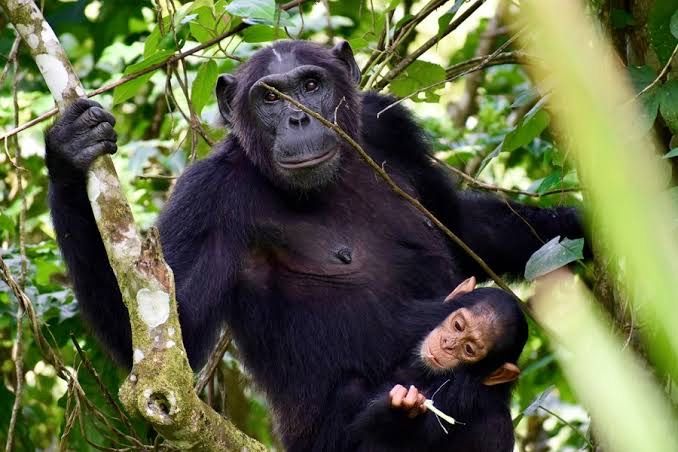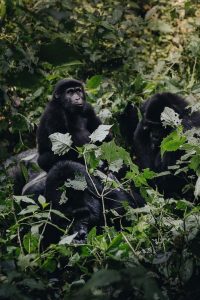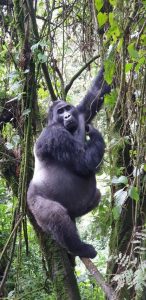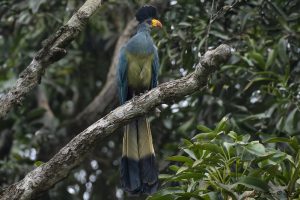Chimpanzee trekking in Gombe and Mahale Mountains offers travelers a chance to experience some of Africa’s most remarkable primate encounters. Both national parks in western Tanzania provide protected habitats where chimpanzees live freely in large numbers. These destinations stand out as some of the best places in the world to observe chimpanzees in their natural environment. This guide explains everything you need to know about chimpanzee trekking in Gombe and Mahale, including locations, permits, costs, and conservation efforts.
What is chimpanzee trekking in Gombe and Mahale Mountains?
Chimpanzee trekking in Gombe and Mahale Mountains involves guided walks through tropical forests to locate and observe wild chimpanzees. Visitors hike with experienced guides who track chimpanzee movements and explain their behaviors. The trekking experience gives travelers opportunities to watch chimpanzees grooming, feeding, communicating, and interacting in family groups. Unlike traditional safaris that focus on savannah animals, chimpanzee trekking takes place on foot in forested areas, creating intimate and immersive wildlife encounters.
Where is Gombe Stream National Park located?
Gombe Stream National Park lies on the northeastern shore of Lake Tanganyika in western Tanzania. It covers about 35 square kilometers, making it the smallest national park in the country. Despite its size, Gombe is world-famous because it hosted Dr. Jane Goodall’s pioneering chimpanzee research beginning in 1960. The park’s terrain includes steep valleys, dense forest, and streams that flow into Lake Tanganyika. Gombe’s remote location ensures that it remains less crowded, providing a quiet and authentic trekking experience.
How many chimpanzees live in Gombe Stream National Park?
Gombe Stream National Park has a population of around 100 chimpanzees. These chimpanzees live in distinct communities, with the most studied being the Kasekela community. Researchers have followed this group for decades, providing valuable insights into chimpanzee behavior, social structures, and intelligence. Visitors trekking in Gombe often encounter members of this community, making it one of the best places to see habituated chimpanzees in East Africa.
Why is Gombe Stream famous for chimpanzee trekking?
Gombe Stream gained international recognition through Dr. Jane Goodall’s long-term chimpanzee research. Her groundbreaking discoveries, such as tool use and complex social behaviors among chimpanzees, made the park a global hub for primate studies. Today, Gombe remains famous for its unique combination of scientific history, small size, and intimate trekking opportunities. Visitors often view chimpanzees at close range, making Gombe a prime destination for primate enthusiasts and wildlife photographers.
Where are the Mahale Mountains located?
Mahale Mountains National Park sits along the eastern shore of Lake Tanganyika, south of Gombe. It covers about 1,613 square kilometers, making it significantly larger than Gombe. The park is dominated by the Mahale mountain range, with Mount Nkungwe rising to 2,462 meters. Dense tropical forests cover the slopes, providing ideal habitats for chimpanzees and other primates. Its remote location means the park is accessible mainly by boat across Lake Tanganyika, adding adventure to the journey.
How many chimpanzees are in Mahale Mountains National Park?
Mahale Mountains National Park hosts one of the largest chimpanzee populations in Africa, with around 1,000 individuals. These chimpanzees live in multiple communities spread across the park. The Mimikire community, numbering more than 50 individuals, is the most habituated to human presence, allowing visitors to observe them closely. The large population size increases the chances of successful chimpanzee encounters during trekking.
What makes Mahale Mountains unique for chimpanzee trekking?
Mahale Mountains stands out for its combination of remote wilderness, scenic landscapes, and abundant chimpanzees. The park offers longer treks than Gombe, often involving several hours of hiking through dense forests. The reward is observing larger groups of chimpanzees in untouched habitats. In addition, Mahale is one of the few parks where chimpanzees share their environment with clear-water beaches along Lake Tanganyika, allowing visitors to combine wildlife trekking with relaxation.
How does chimpanzee trekking in Gombe differ from Mahale?
Trekking in Gombe differs from Mahale in several ways. Gombe is smaller, making treks shorter and more focused, while Mahale covers a vast area that requires longer hikes. Gombe offers stronger historical significance due to Jane Goodall’s research, while Mahale offers larger chimpanzee populations and more remote wilderness experiences. Gombe is easier to access by boat from Kigoma, whereas Mahale requires longer boat journeys or charter flights. Both parks provide rewarding chimpanzee encounters but appeal to different travel preferences.
When is the best time to trek chimpanzees in Gombe and Mahale?
The best time for chimpanzee trekking in Gombe and Mahale is during the dry season from June to October. During these months, trails are easier to navigate, and chimpanzees often gather in lower altitudes near water sources, making them easier to track. The wet season from November to May also offers trekking opportunities, but trails may become slippery and more challenging. However, chimpanzees are still visible year-round, so travelers can plan visits according to personal schedules.
How difficult are the chimpanzee treks in Gombe and Mahale?
Trekking difficulty varies between the two parks. In Gombe, treks are generally short and less strenuous due to the park’s small size, though some steep climbs exist. In Mahale, treks are longer and more demanding, often taking several hours across rugged forest terrain. Visitors should prepare for humid conditions and physical exertion, especially in Mahale. Guides help set trekking paces to suit participants, ensuring a safe and rewarding experience.
What permits are required for chimpanzee trekking in Tanzania?
Visitors need permits issued by Tanzania National Parks Authority (TANAPA) to trek chimpanzees in both Gombe and Mahale. The permits grant access to guided treks with rangers who monitor chimpanzee locations daily. Obtaining permits in advance is recommended, especially during peak travel seasons.
How much does a chimpanzee trekking permit cost in Gombe and Mahale?
Chimpanzee trekking permits in Gombe and Mahale cost around USD 100 per person per trek for foreign non-residents. Fees for residents and East African citizens are lower. Permit costs contribute directly to conservation programs, research initiatives, and community development projects surrounding the parks.
How do you get to Gombe Stream National Park?
Travelers reach Gombe by taking a boat ride from Kigoma town, which lies on the eastern shore of Lake Tanganyika. Boats take about 1 to 2 hours, depending on the type. Kigoma itself is accessible by domestic flights from Dar es Salaam, Mwanza, or Arusha, as well as by road and train connections. Because Gombe lacks roads, boats remain the only way to enter the park.
How do you get to Mahale Mountains National Park?
Mahale Mountains National Park is more remote than Gombe. The most common way to access it is by boat from Kigoma or nearby landing sites, taking between 3 and 6 hours. Alternatively, charter flights from Arusha or Dar es Salaam land at airstrips near the park. From there, boats transfer visitors to lodges or trekking points. The journey adds to Mahale’s sense of adventure and remoteness.
What other wildlife can you see in Gombe and Mahale?
In addition to chimpanzees, Gombe and Mahale host other primates such as red colobus monkeys, olive baboons, and vervet monkeys. Forest birds are abundant, with species like African fish eagles and palm-nut vultures frequenting Lake Tanganyika’s shores. Small antelopes, bush pigs, and forest creatures also live in the parks. The lake itself provides opportunities to see hippos, crocodiles, and diverse fish species.
What are the accommodation options near Gombe and Mahale?
Accommodation options in Gombe include basic guesthouses, bandas, and mid-range lodges near the park entrance. Mahale offers a mix of luxury tented camps, eco-lodges, and budget-friendly bandas along the lake shore. Most lodges provide guided trekking packages, boat transfers, and cultural activities. Staying near the parks ensures easy access to trekking trails and maximizes time with the chimpanzees.
How long does a typical chimpanzee trek last?
A typical chimpanzee trek lasts between 2 and 6 hours, depending on how quickly guides locate chimpanzees and how far they have moved. In Gombe, treks often last 2 to 3 hours, while in Mahale, treks may extend to 5 or 6 hours. Once trekkers reach a chimpanzee group, they spend up to one hour observing them, following guidelines set to protect both humans and chimpanzees.
Are guided tours required for chimpanzee trekking in Tanzania?
Yes, guided tours are required. TANAPA rangers and professional guides lead all treks, ensuring safety and compliance with regulations. Guides also interpret chimpanzee behaviors and provide educational insights. Because chimpanzees move frequently, guides rely on daily tracking updates to locate them. Guided treks guarantee organized experiences and minimize human impact on chimpanzees.
What are the rules for trekking chimpanzees in Gombe and Mahale?
Trekking rules protect both visitors and chimpanzees. Key rules include: maintaining at least 10 meters distance from chimpanzees, avoiding direct contact, limiting observation to one hour, and not trekking when sick to prevent disease transmission. Visitors must also follow group instructions and avoid littering. These rules ensure sustainable tourism while safeguarding chimpanzee health and behavior.
How do Gombe and Mahale support chimpanzee conservation?
Both parks play central roles in global chimpanzee conservation. Gombe continues Jane Goodall’s legacy through research programs and community-based conservation initiatives. Mahale supports one of Africa’s largest chimpanzee populations, with strict protection measures in place. Revenue from tourism funds park management and benefits surrounding communities. International collaborations with organizations like the Jane Goodall Institute and Tanzania National Parks Authority further strengthen conservation efforts.
What is the best itinerary for visiting both Gombe and Mahale?
An ideal itinerary combines Gombe and Mahale for a comprehensive chimpanzee trekking experience. Travelers often begin in Kigoma, spend 2 to 3 days in Gombe for shorter treks, then continue to Mahale for 3 to 4 days of longer trekking adventures. This combination allows visitors to experience both historical significance and vast wilderness. Many itineraries also include time on Lake Tanganyika, cultural encounters with local communities, and relaxation on sandy beaches.
Conclusion
Chimpanzee trekking in Gombe and Mahale Mountains ranks among the most unique wildlife experiences in Africa. Gombe offers intimate encounters within a small, historically significant park, while Mahale provides vast wilderness and large chimpanzee populations. Together, they represent Tanzania’s best chimpanzee trekking destinations. Whether you choose one or combine both, trekking in Gombe and Mahale guarantees unforgettable encounters with our closest relatives in the animal kingdom.




